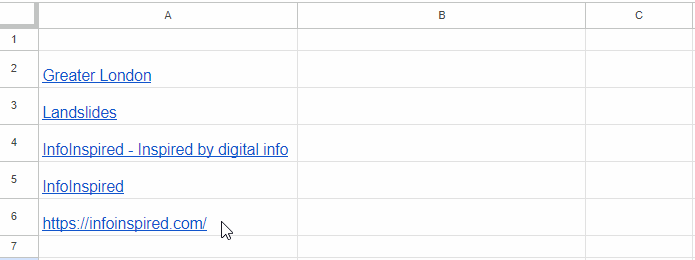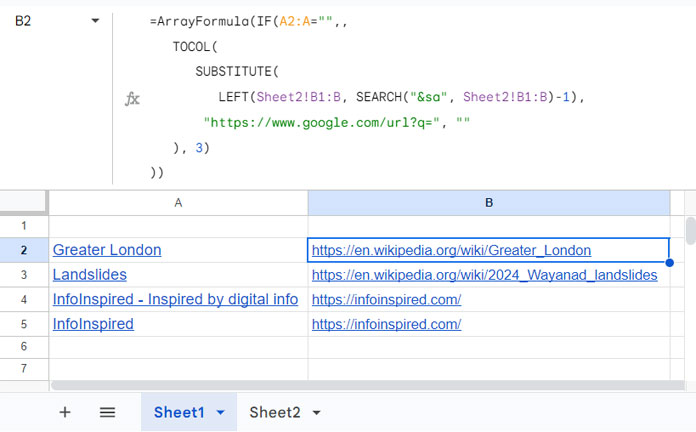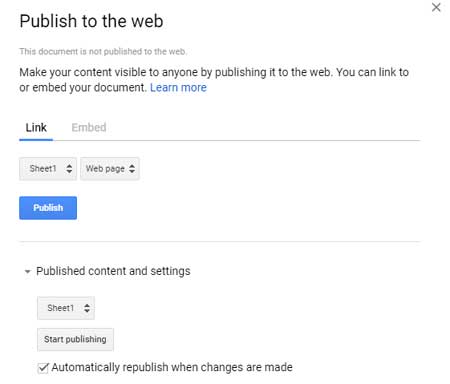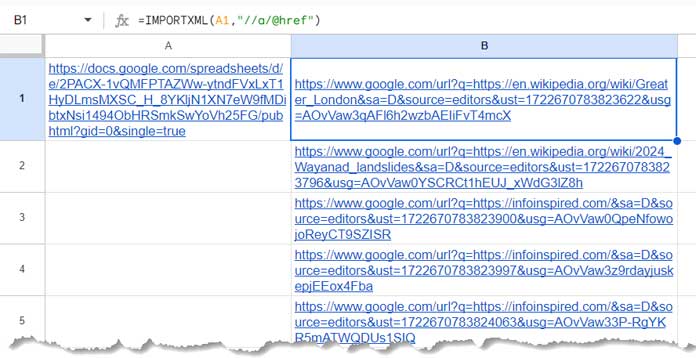Extracting hyperlinks or embedded URLs in Google Sheets is possible without relying on Google Apps Script (GAS).
It doesn’t matter whether the links are (1) formula-based links or (2) embedded links, the method will work flawlessly.
You can refer to the two types of links in Google Sheets as:
- Formula-Based Links: Created using the HYPERLINK function. For example:
=HYPERLINK("https://infoinspired.com/", "InfoInspired"). These are explicitly defined in the cell formula and show the URL when using FORMULATEXT. - Embedded Links: You insert these links using the Insert > Link menu option. These links embed in the cell or text and do not reveal the URL when using FORMULATEXT.
For example, if cell A1 contains a link, =FORMULATEXT(A1) will return the cell formula if it contains a formula-based link. If it doesn’t contain a formula, it will return #N/A.
Extract URLs from Hyperlinks Individually (Built-in Method)
This method allows you to copy a URL from a link in a cell, regardless of whether the link is formula-based or embedded.

Steps:
- Hover your mouse pointer over the link.
- A small box will appear with options to copy, edit, and delete the hyperlink.
- Click on the copy-link icon.
- Right-click any cell and select Paste.
How to Extract URLs from Hyperlinks in a Column (Workaround)

The built-in method is impractical if multiple links are in a column, as copying the URLs individually is time-consuming.
Instead, we will use a workaround that you can easily perform in a few steps without needing knowledge of Google Apps Script.
This method also applies to both formula-based hyperlinks and embedded links.
For example, we’ll consider the range A2:A5 in the tab named “Sheet1” and extract the URLs into B2:B5 in that sheet.
Step 1: Publish the Tab “Sheet1”
In this step, we will publish the sheet on the web. By doing this, Google converts the spreadsheet data into an HTML format, hosts it on its servers, and provides a URL for access.

- Go to the File menu, click on Share, and select Publish to web. Be cautious about publishing sensitive data, as anyone with the link can view the published content. However, you can unpublish it at any time.
- Under Link, select the tab name (i.e., “Sheet1”) in the first drop-down and then select web page in the second drop-down.
- Click Publish.
- Once published, you will get a link URL. Copy that.
Step 2: Import Published Google Sheets Contents Back to Google Sheets
- In cell A1 in “Sheet2” of the same Google Sheets file, right-click and paste the copied URL.
- In cell B1 in “Sheet2”, enter the following formula and wait for it to return a list of all the href values (URLs) found within anchor tags in the given HTML document:
=IMPORTXML(D1, "//a/@href")
Step 3: Extracting URLs
In cell B2 of “Sheet1”, enter the following formula and voila!
=ArrayFormula(IF(A2:A="",,
TOCOL(
SUBSTITUTE(
LEFT(Sheet2!B1:B, SEARCH("&sa", Sheet2!B1:B)-1),
"https://www.google.com/url?q=", ""
), 3)
)Formula Explanation:
- The LEFT function extracts n characters from the left of the strings in Sheet2!B1:B, where n is determined by the SEARCH formula:
SEARCH("&sa", Sheet2!B1:B)-1. - The SUBSTITUTE function replaces “https://www.google.com/url?q=” in the values extracted by the LEFT function with “”.
- The TOCOL function removes errors and empty strings from the output.
- The IF function removes values in the TOCOL output if the corresponding rows in A2:A are blank.
That’s how we can extract multiple URLs from hyperlinks in Google Sheets.
Resources
- How to Label URL in Google Sheets Using HYPERLINK Function
- The ISURL Function in Google Sheets – Check/Highlight/Validate URLs
- UNIQUE Duplicate Hyperlinks in Google Sheets – Same Labels Different URLs
- How to Use ENCODEURL in Google Sheets to Create Clean URLs
- Search Value and Hyperlink Cell Found in Google Sheets
- Create Hyperlink to Vlookup Output Cell in Google Sheets
- How to Create a Hyperlink to an Email Address in Google Sheets
- Hyperlink Max and Min Values in Column or Row in Google Sheets
- Hyperlink to Index-Match Output in Google Sheets
- Inserting Multiple Hyperlinks within a Cell in Google Sheets
- Hyperlink to Jump to Current Date Cell in Google Sheets
- Hyperlink Calendar Dates to Events in Google Sheets
- Using HYPERLINK with FILTER Function in Google Sheets




















You’re the best at this bro. Sending love from the Philippines.
Thanks !
This is really helpful! Thank you, Prashanth.
Hi Prashanth,
I was looking to get the ‘Sheet3’ url into a cell A1 with only formula (without script).
Thank You.
Hi, Bahar,
I don’t find any supporting function in Google Sheets.
As you may know, manually we can do that with right-clicking on Sheet3!A1 and click “Get link to this cell”.
Hi Prashanth,
Thank you for your response, have a great day.
Thank You.
This worked, thank you!
(Note: It does not work if you’re signed in to your company’s Gsuite account. Make sure to sign in to your personal Google account before starting the steps).
Hi, Wayne,
Thank you for your valuable feedback.
Is there a way to get this to work without unrestricted publishing (i.e., within a company G-Suite account)?
Thanks man really helpful
Amazing – Thank you for sharing!
Prashanth,
So, I tried a couple of different things. The sheet I was trying to copy had around 1900 rows of URLs.
Seems like the largest number of rows it will work with is around 1000
To get it to work, I had to break it up into two sheets and just run the process twice.
Pat
Hi,
I think that’s the case.
There are similar issues with all the text functions like, join, textjoin, ampersand sign, concatenate etc.
Best,
Prashanth,
I did everything as outlined above for Google Sheets. When I went to Step 3 it returned the following Error.
“Resource at URL Contents Exceeded Maximum Size”
Thoughts?
Pat
Hi, Pat,
Actually, I was unaware of that issue due to my testing with a limited dataset.
Thanks for the info.
You can try the following workaround.
Remove unwanted rows and columns in your Sheet (published). The aim is to reduce the file size. Then try.
If that doesn’t work, try to import a limited number of rows.
Existing Formula.
=IMPORTXML("URL","//a/@href")Play around with;
=Array_Constrain(IMPORTXML("URL","//a/@href"),500,1)This formula imports 500 rows and 1 column.
But I didn’t test any of the above workarounds.
Thanks for your understanding.
Best